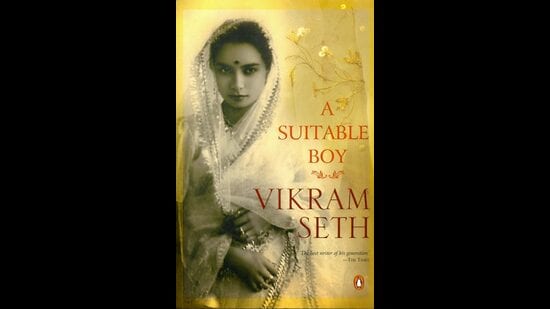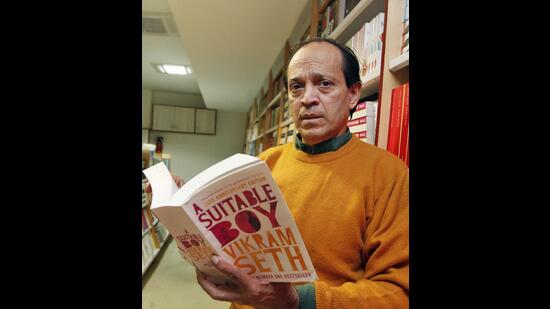In India, the ability to communicate in English amounts to being in on an exclusive secret. Like having magic beans which grow into a stalk leading to a vast mansion of undefined treasures in the clouds. Nobody really knows how to reach the heights, let alone harvest the tempting jewels to good use. But then again, the belief that one can climb up the stalk/social ladder by being fluent in the language is collectively agreed upon. In this English-speaking and English-dreaming world, one of the many giants guarding the clouds is Vikram Seth’s 1993 novel, A Suitable Boy. Everyone seems to know about it. 31 years since its publication on 13th April, 1993, quite a few of us have dared to read it too. And dared we have. For it is no easy feat to force-stop the mechanical whirs of everyday life and conjure huge pockets of time to spend with a tome that is more than 1,400 pages long. It has often been called the great Indian novel. But is it?

An early edition of the book (Amazon)
Set in the Gangetic plains in the fictional town of Brahmpur, and frequently crossing its borders into Lucknow, Calcutta and far-off Delhi, the book is about four families in post-independence India. The movement within the novel is provided by a simple motivation: Mrs Rupa Mehra’s tireless hunt for a suitable boy for her daughter Lata. Seth’s role is of the bhāt: a bard or genealogist. With unrelenting patience, he introduces episode after episode and character after character that enrich his simple story, and elevate it to the cult classic it has become. However, despite its title, the hunt for a suitable boy is only one among its countless strains and subplots. Along with being a chronicle of the intertwined lives of the characters and families, it is also a veiled history of a newly-independent nation.
Early Indian reviews were mixed. The Economic Times pronounced: “The book has length, but lacks the sweep, the majesty, the range and the insight of the great books.” In India Today, Tarun Tejpal called the prose “straightforward, bland, the writing mundane.” The international press, on the other hand, was brimming with raves. Christopher Hitchens profiled Seth for Vanity Fair, and heaped praises on the book. Seth was offered $1.1 million in book deals and Indian critics who did not agree with the international media were accused of being jealous.
It is a truth universally acknowledged that writing in India is not a money-making business at all, so how could Seth get away with this heist? Is the book really that good?
Seth’s character Amit Chatterji is a lot like the author himself. At one point, talking to Lata about his writing, he describes the form of the novel as a banyan tree: “It sprouts, and grows, and spreads, and drops down branches that become trunks or intertwine with other branches. Sometimes branches die. Sometimes the main trunk dies, and the structure is held up by the supporting trunks.” This reads like a self-referential postmodern trick with the novelist describing his work via a character. Seth, however, has declared a trenchant dislike for avant-garde techniques and has always taken comfort in his work being described as a synthesis of the narrative and stylistic tools that seem to have been discarded by his contemporaries. “He writes as if Salman Rushdie had never written Midnight’s Children or The Satanic Verses, firmly turning his back upon the unconfined imagination and dangerous fantasy,” writes Anita Desai. Is he then really a chronicler of an old world in an old language, unvarnished by the wear of time and restless experimentation?

A scene from the 2020 TV series based on the novel.
A loophole in time
Many of the events in the novel seem prescient to the contemporary reader. Indeed, they were prescient even 31 years ago when Babri Masjid was razed in December 1993.
“The construction of the Shiva Temple was going ahead. The Imam’s appeals to everyone from the Governor down had fallen on deaf ears… A stay order on the construction of the [temple] could not be immediately obtained – indeed, perhaps could not be obtained at all…”
When asked about this particular episode after the fall of the mosque, Seth said: “It was a most unhappy prefiguration of events… What it must feel like to be a non-Hindu in this country, how insecure it must make you feel. Many, many, many Hindus are shocked and ashamed.”
In another unnerving episode in the novel, a Hindu mob tries to lynch one of the Muslim protagonists, Firoz Khan. The sadly familiar scenario has the crowd demanding that he undress so they can “verify” his religion.
The novel also repeatedly examines and exposes fraught class and caste relations in India. Seth’s business is not, however, of the activist or educator. His characters are real. They openly utter derogatory remarks and display biases much like people do during dinner table conversations today and in WhatsApp groups.
Perhaps recognising the stultifying effect of political correctness on creativity and the deathly kiss of didacticism, Seth has disavowed a “social function” of the novel. This has irritated some reviewers. Here’s a particularly scathing one on Kirkus Reviews: “Dull and soapy in final effect… lots of stuff obviously – at a marathon 1300-plus pages – but characters made out of cliché, with background-India the very stuffed pillow of local colour that keeps them standing. The book, too, fairly squeaks with its own pleasure in itself, larded with poetry and a general recommendation of art over politics and money: the characters it spends the most time over are narcissists.”
While much of the novel is remarkably engaging, in its Austenian foibles and callbacks, the final chapters might force you to acknowledge the truth of this unsparing review.
In the final chapters, the novel unravels, and the novelist perhaps becomes a bit unserious, even narcissistic like his favourite characters. The fictionality of the novel begins to seem farcical; the melodrama peaks. Against this backdrop, Nehru appears out of nowhere and is given lines of dialogue. It is ludicrous. The moment the “reality” of fiction becomes unreal, the plot drops. It would seem that the novelist has gone astray.
A character as enigmatic, self-defined and mercurial as Saeeda Bai is reduced to a helpless fanatic. A hilarious and infuriating mockery is made of the court of law when Maan is acquitted of his crime, after the main witness and victim withdraws his accusations. As the glut of action and drama in the novel develops – unfortunately written in sheer disregard for the preceding grace and slowness of the narrative – we come closer to the end of the titular quest as well. It is here, finally, that the screaming question of “why?” rises. Why does the book go up to 1400 pages at all? In her essay on the book in The New York Review, Desai answered: “It is precisely by interweaving [multiple] tales with such skill into patterns of such intricacy that Seth achieves his effect of bulk and mass impossible to overlook.” Perhaps, this is the biggest achievement of the novel, that it has been impossible to overlook, irrespective of its somewhat poorly executed finale.
In the end, despite spending so much time with Seth’s characters, the reader knows little about how they live their lives. And what is revealed about their emotional inner lives is often disappointing. As a story perhaps A Suitable Boy flies, but as a novel, it somewhat flounders.

Vikram Seth in a picture dated December 16, 2013. (Sanjeev Verma/Hindustan Times)
Should you read A Suitable Boy?
Seth registers one more interesting self-referential comment on the form of the novel via Amit Chatterji, in which he compares novel writing and raag compositions:
“You know… first you take one note and explore it for a while, then another to discover its possibilities, then perhaps you get to the dominant, and pause for a bit, and it’s only gradually that the phrases begin to form…”
Despite its pitfalls, the book is musical in its own way. The structure of the novel, both as a banyan tree with sprawling branches and a nuanced raag which performs overall a mostly unforgettable melody, hinges on the author’s facility with language. Another achievement is that it rarely states that certain values and morals are correct and others are not. In fact, the faults of the characters are the lifeblood of this story. The limbs, however, are the writer’s expediency with language.
Seth, like bhāts engaged in the business of documenting ordinary lives, keeps it going. And keeps you turning page after page, even when you feel like throwing the tome across the room. Only the most gifted storytellers have that magical power to induce such endurance in us.
Kartik Chauhan is an independent reviewer and writer. He lives in New Delhi.
Read more news like this on HindustanTimes.com
News Related-
Anurag Kashyap unveils teaser of ‘Kastoori’
-
Shehar Lakhot: Meet The Intriguing Characters Of The Upcoming Noir Crime Drama
-
Watch: 'My name is VVS Laxman...': When Ishan Kishan gave wrong answers to right questions
-
Tennis-Sabalenka, Rybakina to open new season in Brisbane
-
Sikandar Raza Makes History For Zimbabwe With Hattrick A Day After Punjab Kings Retain Him- WATCH
-
Delayed Barapullah work yet to begin despite land transfer
-
Army called in to help in tunnel rescue operation
-
FIR against Redbird aviation school for non-cooperation, obstructing DGCA officials in probe
-
IPL 2024 Auction: Why Gujarat Titans allowed Hardik Pandya to join Mumbai Indians? GT explain
-
From puff sleeves to sustainable designs: Top 5 bridal fashion trends redefining elegance and style for brides-to-be
-
The Judge behind China's financial reckoning
-
Arshdeep Singh & Axar Patel Out, Avesh Khan & Washington Sundar IN? India's Likely Playing XI For 3rd T20I
-
Horoscope Today, November 28, 2023: Check here Astrological prediction for all zodiac signs
-
'Gurdwaras are...': US Sikh body on Indian envoy's heckling by Khalistani backers
